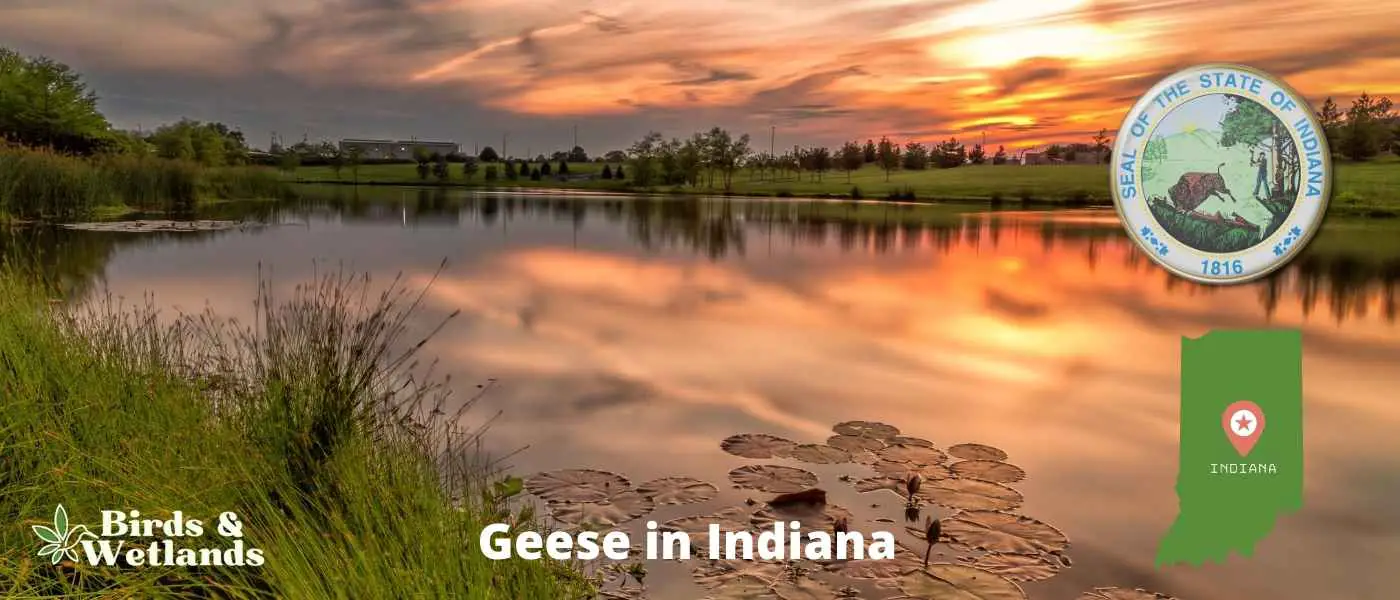If you’re looking for an interesting bird to watch while in Indiana, you’re in luck. There are four different species of geese and three swan species that call this state home.
What Geese Are in Indiana?
| Goose | Frequency in Indiana | Resident Population | Specific Locations in Indiana |
|---|---|---|---|
| Canada Goose | Very Common | Yes | Eagle Creek Park, Indianapolis |
| Snow Goose | Common during migration | No | Goose Pond Fish and Wildlife Area |
| Cackling Goose | Common during migration | No | Patoka River National Wildlife Refuge |
| Greater White-fronted Goose | Less Common | No | Kankakee Fish and Wildlife Area |
Indiana is also the home of 3 swan species – Tundra Swan, Trumpeter Swan and Mute Swan
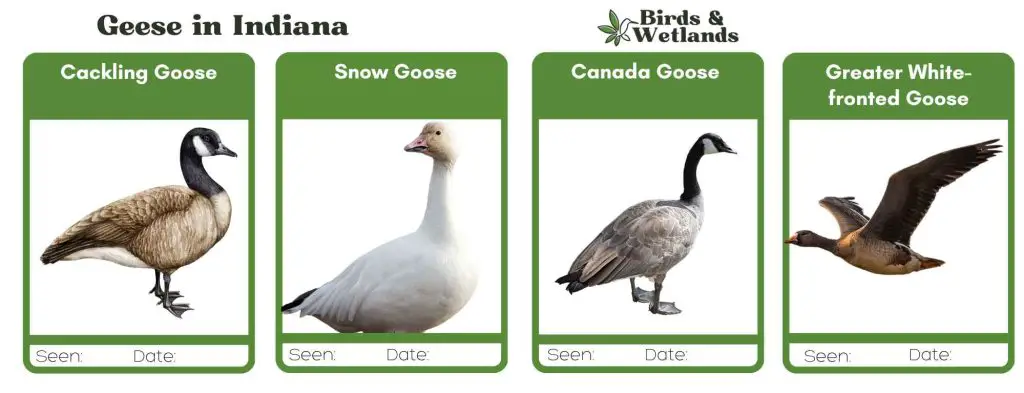
Canada Goose


Canada Goose Sound
Scientific Name: Branta canadensis
Length: 30 to 43 in
Wingspan: 50–73 in
Weight: 5.7–14.3 lb
The Canada Goose is a large, well-known species of waterfowl noted for its distinctive appearance, familiar “honk,” and migratory behavior.
Appearance: Both male and female Canada Geese have a similar appearance, featuring a black head and neck with distinctive white patches on the cheeks and chin. The body is primarily brown with a lighter, often white, underbelly.
Diet: Canada Geese primarily feed on plant matter, including grasses, aquatic vegetation, and grains. They can often be seen grazing in parks, lawns, and fields, as well as dabbling in water bodies.
Reproduction: Canada Geese typically nest on the ground near water bodies, often on islands or other isolated areas to avoid predators. The female lays a clutch of about 4 to 6 eggs, which she incubates alone for around a month.
Indiana serves as an essential corridor for various subspecies of Canada Geese during their biannual migrations. Each spring and fall, these geese can be observed traversing the state’s diverse landscapes, from its large wetlands and open water bodies to its agricultural fields.
Each subspecies, such as the Greater Canada Goose, the Lesser Canada Goose, and the interior Canada Goose, among others, exhibits slight differences in size, coloration, and call. The population of Canada geese decreases drastically as Canada geese migrate. Migration Canada geese can be recongised by their V shaped flying formations
The resident canada goose population is mainly the Giant canada goose, with the typical canada goose living up to 25 years. Remember that feeding Canada geese is not encouraged. Adult geese, especially giant canada geese can get quite aggressive during breeding season.
Increasing Canada Goose populations in shared habitats cause complex can lead to excessive algae growth in bodies of water, a process known as eutrophication as canada geese feed on grasses and crops. Adult canada geese undergo a full molt of their flight feathers in the summer months.
Snow Goose

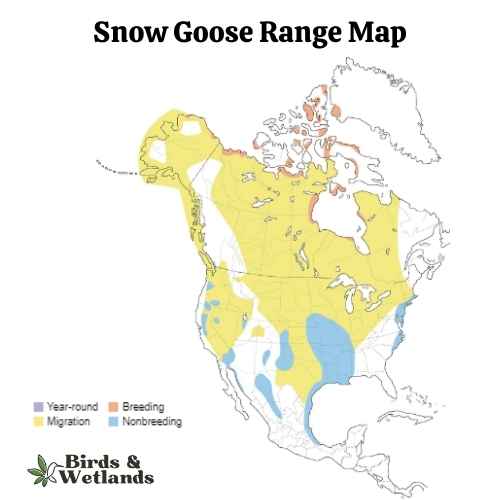
Snow Goose Sound
Scientific Name: Anser caerulescens
Length: 25 to 31 in
Wingspan: 53 to 65 in
Weight: 4.5 to 6.0
The Snow Goose is a large species of waterfowl known for its vibrant white plumage and significant migratory flights.
Appearance: True to their name, Snow Geese are predominantly white with black wingtips. They also have a pink bill, pink legs and feet. A color morph, known as the “Blue Goose,” displays a bluish-gray body with a white head, but is considered the same species.
Diet: Snow Geese primarily feed on plant matter, such as grasses, sedges, and small grains. They can often be seen in large flocks foraging in fields and marshes, and during migration and winter, they can cause considerable damage to agricultural fields due to their feeding habits.
Reproduction: Snow Geese typically nest on the tundra, near water bodies. The female builds the nest and lays a clutch of about 3 to 5 eggs, which she incubates alone for approximately three weeks. Once hatched, the goslings can feed themselves but stay with their parents for protection until they can fly.
Snow Geese are most commonly found in the wetlands, lakes, and agricultural fields of Indiana during migration periods. Notable locations include the Goose Pond Fish and Wildlife Area, a significant stopover for migratory birds, and the Jasper-Pulaski Fish and Wildlife Area, renowned for waterfowl migration.
These places offer large, open spaces and abundant food resources, making them attractive for Snow Geese. Their arrivals are significant events for local birdwatchers and nature enthusiasts. Their presence also signifies challenges for the agricultural sector due to crop damage from foraging.
Cackling Goose
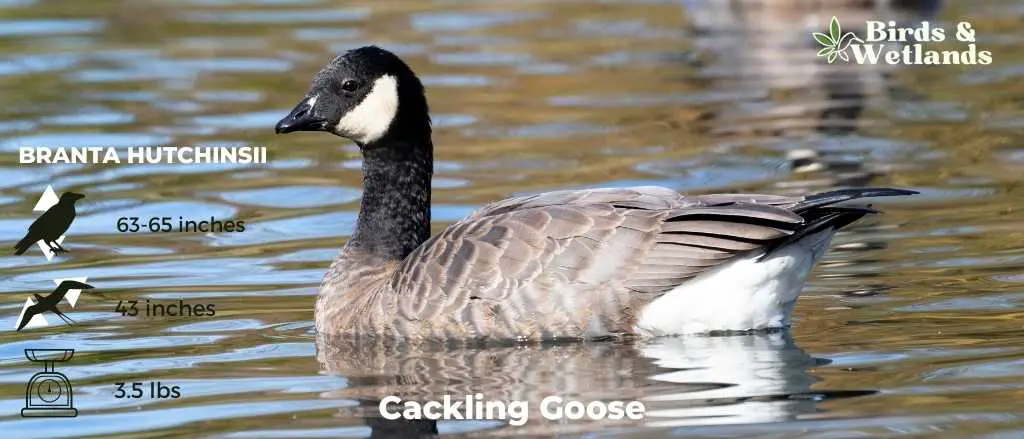
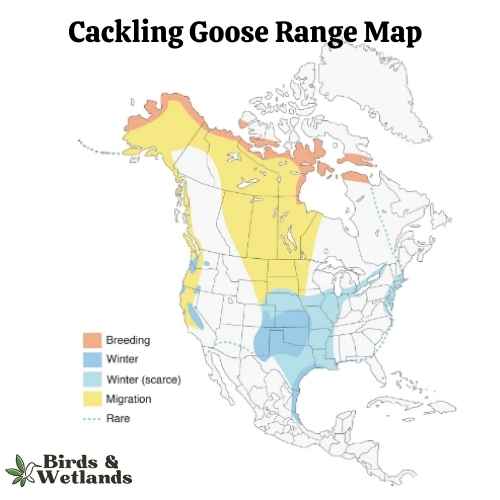
Listen
Scientific Name: Branta hutchinsii
Length: 24.8–25.6 in
Wingspan: 43-45.7 in
Weight:3.5 lbs
Cackling Geese are particularly known for their high-pitched, cackling calls, which is the source of their name. Despite their small size, these geese are renowned long-distance migrants, with some populations traveling thousands of miles between breeding and wintering grounds.
Appearance: With a similar color pattern to the larger Canada Goose, the Cackling Goose features a black head and neck, white chinstrap, light tan to cream chest, and brownish-grey body. One defining characteristic is its noticeably smaller size and stubbier neck compared to its larger counterparts.
Diet: Like many geese, the Cackling Goose’s diet mainly consists of plant matter. This includes grasses, seeds, and aquatic vegetation. They are often seen grazing on land or dabbling in shallow water.
Reproduction: Cackling Geese usually nest on the ground in elevated areas near water bodies, such as riverbanks or lakeshores. The female lays a clutch of 2 to 8 eggs and is responsible for incubation, while the male stands guard nearby. Incubation lasts for about a month.
In Indiana, Cackling Geese can be spotted during migration periods in locations where waterfowl are typically found. The Goose Pond Fish and Wildlife Area, as well as the Jasper-Pulaski Fish and Wildlife Area, are notable spots. These sites offer large expanses of open water and fields, providing ideal resting and feeding grounds for migrating geese.
As Cackling Geese are more elusive than some other waterfowl, be sure to check recent bird sightings on local birdwatching websites or through the Audubon Society for up-to-date information on where they’ve been observed.
Greater White-fronted Goose
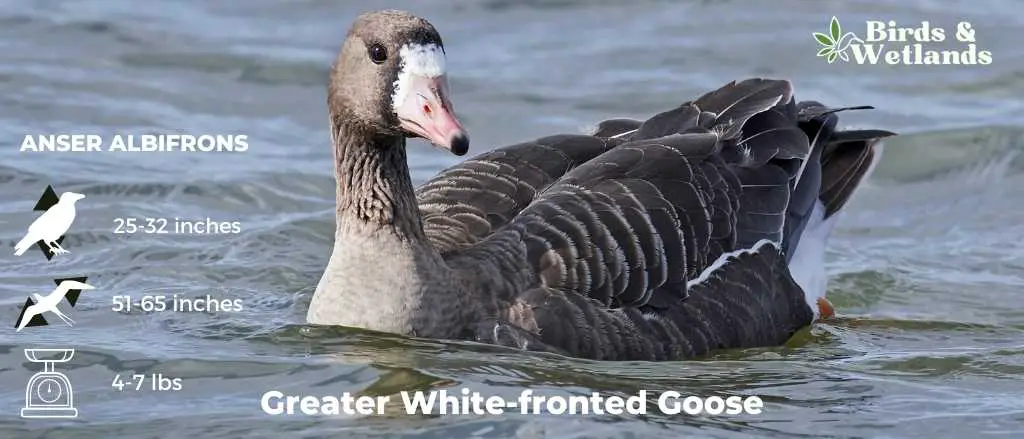

Listen
Scientific Name: Anser albifrons
Length: 25 to 31 in
Wingspan: 53 to 66 in
Weight: 3.3 to 6.6
The Greater White-fronted Goose is a medium to large waterfowl species, widely distributed across the Northern Hemisphere, particularly in North America.
Appearance: As the name suggests, these geese display a prominent white patch at the base of their bill. Their bodies are gray-brown, and their breasts are often marked with dark blotches. They possess a pinkish bill and orange legs and feet.
Diet: The Greater White-fronted Goose is a herbivore and feeds mainly on plant material. Its diet consists of grasses, sedges, grains, and berries. When wintering, these geese can often be found in agricultural fields, feasting on leftover grains and crops.
Reproduction: This species nests on the ground, often in areas with good visibility such as slopes or ridges. The female lays a clutch of 4 to 5 eggs, which she incubates for nearly a month. Once hatched, the young ones are taken care of by both parents until they are able to fly.
Does Indiana Have a Resident Goose Population?
Indiana has a resident population of Canada geese, and the state’s wetlands provide an ideal habitat for these birds.
Canada geese are a common sight in Indiana, and they play an important role in the state’s ecosystem. Canada geese are omnivores, and they help to keep the vegetation in check. They also provide food for predators, such as foxes and coyotes.
In addition, Canada geese are waterfowl, and they help to keep the water clean by eating aquatic plants and animals.
Canada geese typically mate for life, and they return to the same nesting location each year.
Where to Spot Indiana’s Geese
- Goose Pond Fish and Wildlife Area, Linton: A premier location for birdwatching in Indiana. The expansive wetlands here serve as an important stopover for migratory geese.
- Jasper-Pulaski Fish and Wildlife Area, Medaryville: Renowned for waterfowl migration, especially during fall, when thousands of Sandhill Cranes and various geese species congregate here.
- Eagle Creek Park, Indianapolis: One of the largest city parks in the U.S., it boasts a rich birdlife, including multiple geese species, around its reservoir and wetlands.
Here are Indiana’s neighboring states with top geese-viewing locations:
- llinois Geese | Montrose Point Bird Sanctuary, Emiquon National Wildlife Refuge
- Michigan Geese | Shiawassee National Wildlife Refuge, Pointe Mouillee State Game Area
- Ohio Geese | Ottawa National Wildlife Refuge, Magee Marsh Wildlife Area
- Kentucky Geese | Ballard Wildlife Management Area, Sloughs Wildlife Management Area
Hunting Geese in Indiana
In Indiana, waterfowl hunting licenses are required for anyone wishing to hunt ducks or geese.
These can be obtained from the Indiana Department of Natural Resources. In addition to a license, hunters must also have a signed Indiana Migratory Waterfowl Stamp and a HIP validation number.
These can be obtained at any license branch.
All persons 16 years or older must have a signed federal duck stamp to hunt waterfowl.
Can You Hunt a Goose in Indiana?
The state of Indiana implements aggregate daily bag and possession limits.
Dark Geese which includes Canada, White-fronted, and Brant has a bag limit of five and possession limit of three times the daily bag limit.
Light Geese which include Snow (Blue) and Ross’s Geese have a bag limit of twenty and no possession limit.
Where Can You Hunt Geese in Indiana?
If you’re looking to hunt geese in Indiana, you have a few different options.
You can participate in a reserved waterfowl hunt at Goose Pond, LaSalle, Kankakee, Kingsbury, Hovey Lake, Willow Slough Fish and Wildlife areas, Lake Monroe, or Brookville Reservoir.
Or, if you’d prefer to hunt on your own, you can find geese in many different parts of the state – just make sure to get the necessary permits first.
Is There a Goose Hunting Season In Indiana?
Yes, the goose hunting season in Indiana is from September to February. A few Canada Geese choose to remain on golf courses and don’t migrate south with the majority of the geese population. Whilst its just a few adults each year, it can soon lead to over population.

